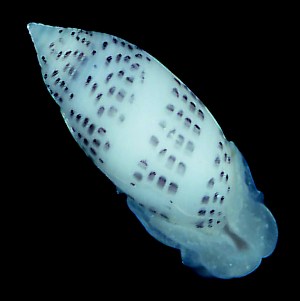
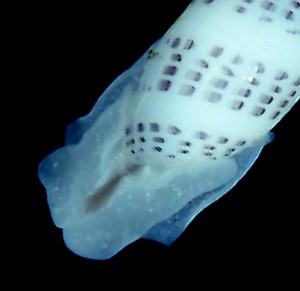
Pupa strigosa
(Gould, 1859)
Order: CEPHALASPIDEA
Superfamily: ACTEONOIDEA
Family: Acteonidae
DISTRIBUTION
Indo-West Pacific
PHOTO
Lifou, Loyalty Ids, November 2000. Shell 10 mm long. Note brown median band on head. PHOTO: Bill Rudman.
This is one of the most common of the tropical members of the genus. It is white with black spots as in P. solidula, but the shell is more slender and the black spots are usually separated into three wide bands on the body whorl by three white spiral lines. Widespread throughout the Indo-West Pacific. Solidula affinis A. Adams, 1855 is probably an earlier name for this species but the name Pupa affinis had already been used for landsnails [Rossmaessler, 1839; Aradas & Maggiore, 1843] so is unavailable.
Note added May 2009: In southeastern Australia this species has commonly been identified as Pupa fumata (Reeve, 1865), but the shell colouration falls within the variation found elsewhere in P. strigosa, so I consider it to be another synonym.
See P. solidulaand Japonacteon suturalis.
-
Gould, A.A., (1859). Descriptions of new species of shells brought home by the North Pacific Exploring Expedition. Proceedings of the Boston Society of Natural History, 7: 138-142.
Rudman, W.B., 2001 (February 4) Pupa strigosa (Gould, 1859) . [In] Sea Slug Forum. Australian Museum, Sydney. Available from http://www.seaslugforum.net/find/pupastri
Related messages
Colour variation in the shell of Pupa strigosa
June 3, 2009
From: Bill Rudman
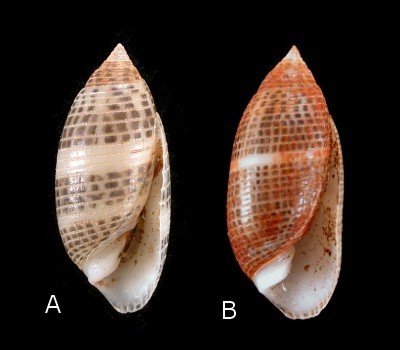
To acompany the message from Gary Cobb and Dave Mullins [#22463], here are some examples of the colour variability in Pupa strigosa.
Pupa strigosa is one of the most common of the tropical members of the genus. It is white with black spots as in P. solidula, but the shell is more slender, and the black spots are usually separated into three wide bands on the body whorl by three white spiral lines. However in some animals the black spots are not separated into bands, and in others, the spots merge to form blackish longitudinal bands down the shell. All variations can be found in single populations and the differences are not related to locality. To show this I have included examples of animals from the far north of tropical Queensland to the temperate waters of Sydney Harbour.
The orange-brown colouration on some shells is a thin organic, non-calcareous layer called the periostracum. It is present in many acteonids but is often transparent. In others it is worn off and only remains in the spiral grooves.
Widespread throughout the Indo-West Pacific. Solidula affinis A. Adams 1855 is probably a synonym of strigosa. But seems there are earlier usages of Pupa affinis (Rossmaessler, 1839; Aradas & Maggiore, 1843). In southeastern Australia it has commonly been identified as Pupa fumata (Reeve, 1865).
A. B. Dingo Beach, Cape Gloucester, Queensland, Australia. pre 1952. AM C75572. Shell length: A - 11.9 mm; B - 14.5 mm. C. D. E. Lady Musgrave Is, Bunker Group, Great Barrier Reef, QLD, Australia. Lagoon, pre 1961. AM C435193. Shell length: C - 16.7 mm; D - 13.6 mm; E - 14.0 mm. F.G. off The Spit, Middle Harbour, Sydney, NSW, Australia. pre 1980. AM C435217. Shell length: F - 15.15 mm, G - 14.1 mm. Photos: D.L.Beechey.
Best wishes
Bill Rudman
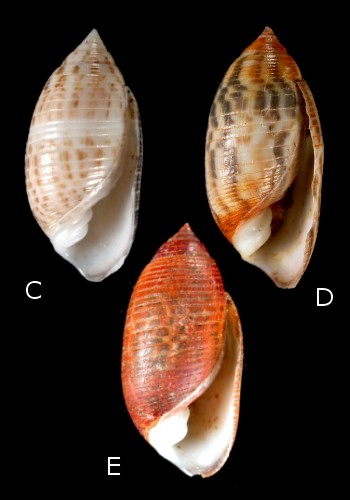
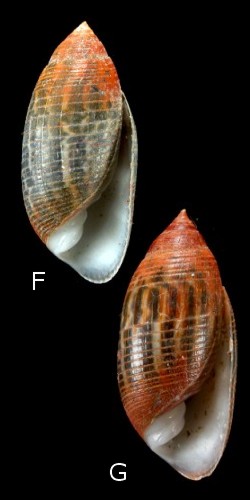
Pupa kirki or Acteon sp. found sthn Queensland
June 3, 2009
From: Gary Cobb
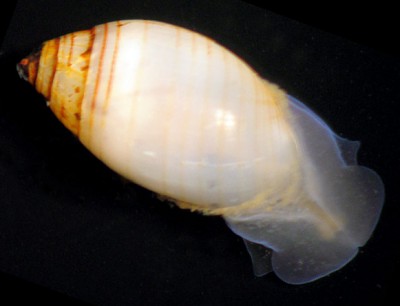
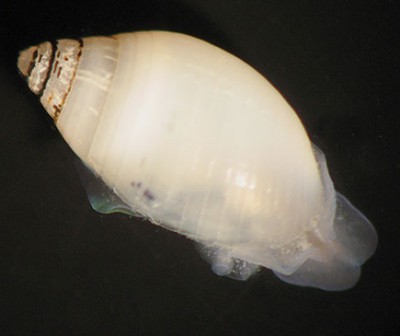
Concerning message #10010:
Hi Bill and everyone!
As you know now, David and I are searching for bubbles. "Around the corner" from Woody Point there is a sailing club. At low tide we have sieved the sandy areas and have found hundreds of these bubbles. With each sieve there are 4-5 found.
Locality: Woody Point, Red Cliffe Peninsula, 50-100 mm, Queensland, Australia, Pacific Ocean, 09 May 2009, Intertidal. Length: 4-10 mm. Photographer: Gary Cobb and David Mullins.
We are not sure what species they are. They resemble Pupa kirki. Or are possibly Acteon?.
We have used the microscope to shoot them and have not seen any eye spots! The whorls of the shells on most of them have a black residue in the fold. There is also orange colouratiion on the shells too.
Over to you!
Cheers Gary and David
gary@nudibranch.com.au
Cobb, G.C., 2009 (Jun 3) Pupa kirki or Acteon sp. found sthn Queensland. [Message in] Sea Slug Forum. Australian Museum, Sydney. Available from http://www.seaslugforum.net/find/22463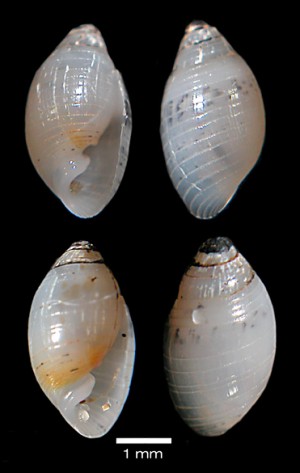
Dear Gary & David,
These are juveniles, so I can't be 100% sure, but I think they are Pupa strigosa. In a separate message [#22517] I have posted some photos showing colour variation in that species, which has been variously called Pupa fumata, Pupa strigosa and Pupa affinis. It definitely has similarities to the New Zealand species P. kirki and it may need DNA studies to determine their relationship to each other.
The orange-brown colour is the remanins of the thin organic layer, called the periostracum, which is found to varying degrees, on the outside of mollusc shells. Some groups, such as the triton shells [Family Ranellidae], have developed the periostracum did a remarkable degree.
The eyes in acteonids are usually embedded deeply in the body wall, or in fact below the body wall so are not usually visible. Species of Pupa can be identified by the heavy double columellar fold on the inside edge of the shell opening.
Best wishes,
Bill Rudman
Pupa strigosa ? from Noumea
June 11, 2001
From: Claude Berthault
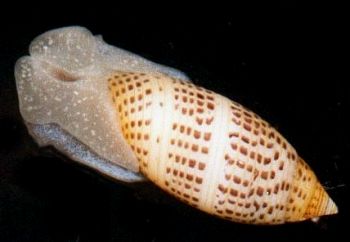
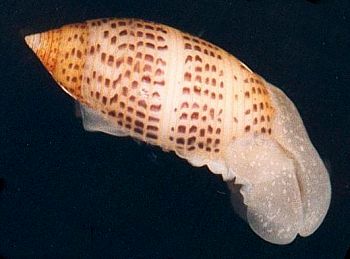
Hello Bill,
I send 2 photos of a living Pupa, perhaps P. strigosa?, found at Anse Vata, Noumea, New Caledonia at a depth of ~2 m.
Please, could you give me the name of this specimen ?
Best wishes
Claude Berthault
Noumea
berthault@noumea.ird.nc
Berthault, C., 2001 (Jun 11) Pupa strigosa ? from Noumea. [Message in] Sea Slug Forum. Australian Museum, Sydney. Available from http://www.seaslugforum.net/find/4535Dear Claude,
Yes this is Pupa strigosa. When I posted photos of the living animal from Lifou recently I noted that the foregut could be seen through the translucent body wall as a brownish line. I suggested that this median brown line on the head shield may be a distinctive character of this species as I had not noted it in other species I had seen alive. Your photo also shows this brown mark. It also shows scattered opaque white patches which are also present in my photo. Perhaps this will turn out to be another feature of the species.
Best wishes,
Bill Rudman
Pupa strigosa
February 6, 2001
From: Cynthia Trowbridge
Dear Bill,
Hi! I just came across an exciting and important new paper on the mitochondrial gene sequences of the Japanese opisthobranch Pupa strigosa. I was wondering if you might have a photo of this species?
Kurabaysahi, A. & R. Ueshima. 2000. Complete sequence of the mitochondrial DNA of the primitive opisthobranch gastropod Pupa strigosa: Systematic implication of the genome organization. Mol. Biol. Evol. 17: 266-277.
Thanks!
All the best,
Cynthia
trowbric@ucs.orst.edu
Trowbridge, C., 2001 (Feb 6) Pupa strigosa. [Message in] Sea Slug Forum. Australian Museum, Sydney. Available from http://www.seaslugforum.net/find/3109
Dear Cynthia,
I am sure you thought I had lost this message of yours from last October about Pupa strigosa, but as I didn't have a decent photo I put it on my 'shopping list' when I went to Lifou. I asked Jean Tröndlé, a very experienced amateur shell collector, to look out for some, and he didn't fail me. So here is a photo for you. How's that for service!
Pupa strigosa is one of a number of species of acteonid with a pattern of black spots on the shell, and I suspect many records of these species will need to be re-examined. An interesting external feature I noticed in the live animals was the brown median line on the head which is part of the foregut showing through the almost transparent body wall. This is the only species I know of which shows this brown band.
[The locality information I am including with photos from Lifou 2000 is very minimal. As soon as the Station data is standardised I will fill in the details]
Best wishes,
Bill Rudman
